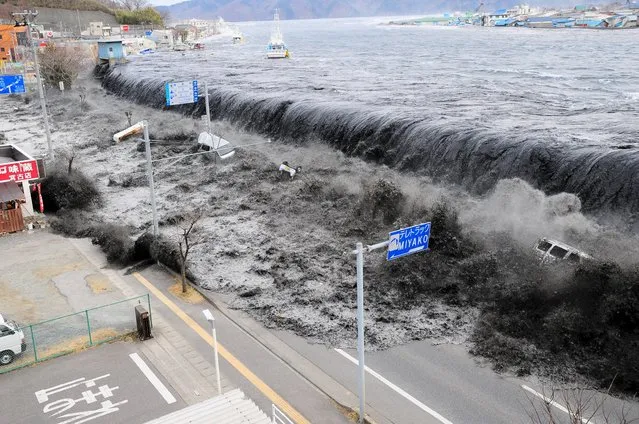
A wave approaches Miyako City from the Heigawa estuary in Iwate Prefecture after the magnitude 8.9 earthquake struck the area March 11, 2011. Five years on from the tsunami that triggered meltdowns at Japan's Fukushima nuclear plant, the page is anything but turned. A magnitude 9 earthquake and towering tsunami on March 11, 2011 killed nearly 16,000 people along Japan's northeastern coast and left more than 2,500 missing. The 10-metre (33-foot) tsunami swept away everything in its path, including houses, ships, cars and farm buildings. (Photo by Mainichi Shimbun/Reuters)
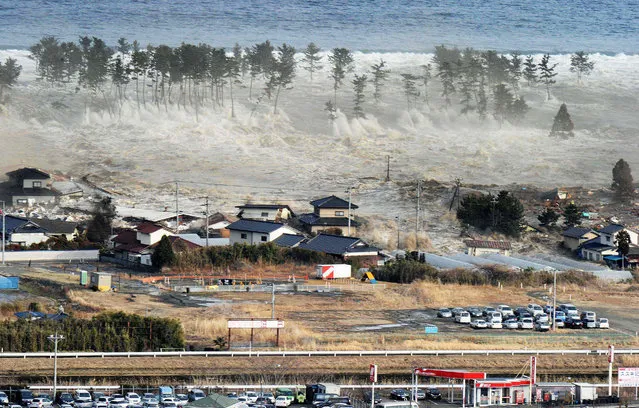
In this March 11, 2011 file aerial photo, waves of tsunami hit the residential area following a powerful earthquake in Natori, Miyagi Prefecture, northeastern Japan. (Kyodo News via AP Photo)
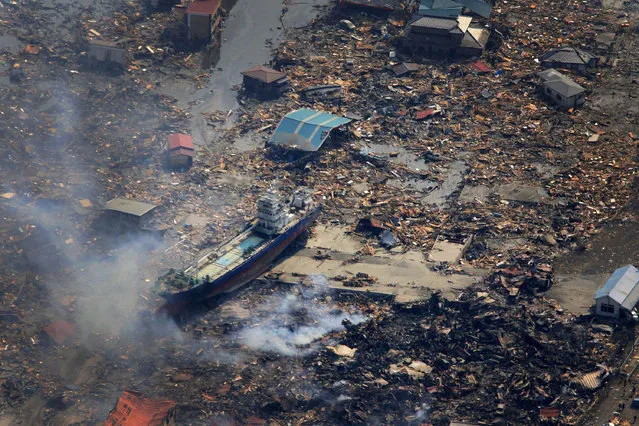
In this March 13, 2011 file aerial photo, a ship washed away by tsunami sits amid debris in Kesennuma, Miyagi Prefecture, northeastern Japan, two days after a powerful earthquake and tsunami hit the area. (Photo by Itsuo Inouye/AP Photo)
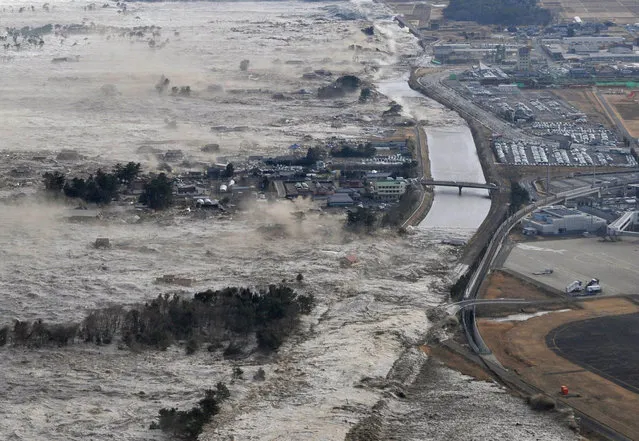
In this March 11, 2011 file aerial photo, an earthquake-triggered tsunami sweeps shores along Iwanuma, Miyagi Prefecture, northeastern Japan. (Kyodo News via AP Photo)
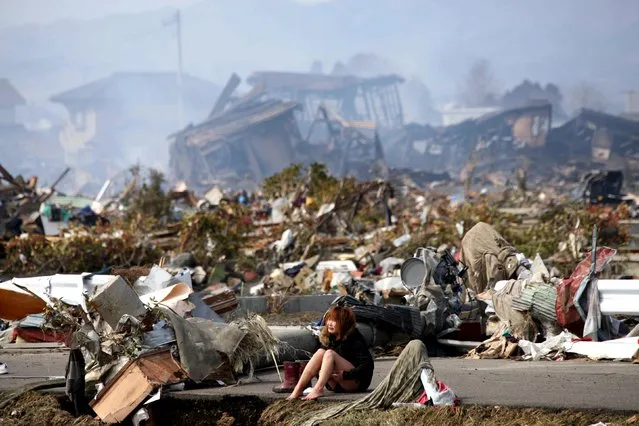
A woman cries while sitting on a road amid the destroyed city of Natori, Miyagi Prefecture in northern Japan March 13, 2011, after a massive earthquake and tsunami that are feared to have killed more than 10,000 people. (Photo by Asahi Shimbun/Reuters)
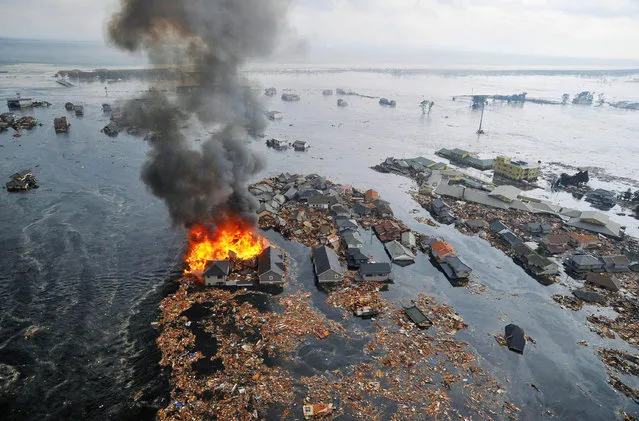
In this March 11, 2011 file aerial photo, houses swallowed by the tsunami burn in Natori, Miyagi Prefecture, northeastern Japan. (Kyodo News via AP Photo)
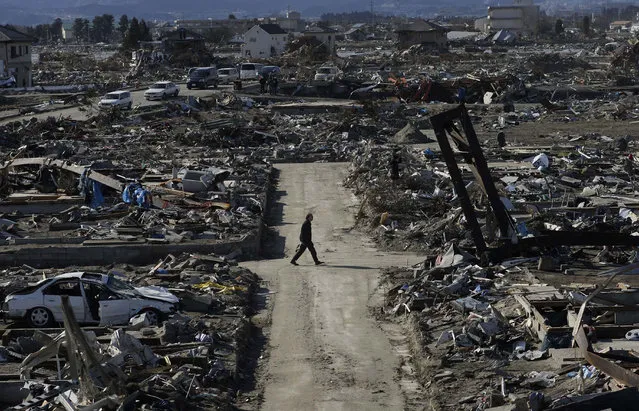
In this March 27, 2011 file photo, a man walks through the destroyed neighborhood below Weather Hill in Natori, Japan. (Photo by Wally Santana/AP Photo)
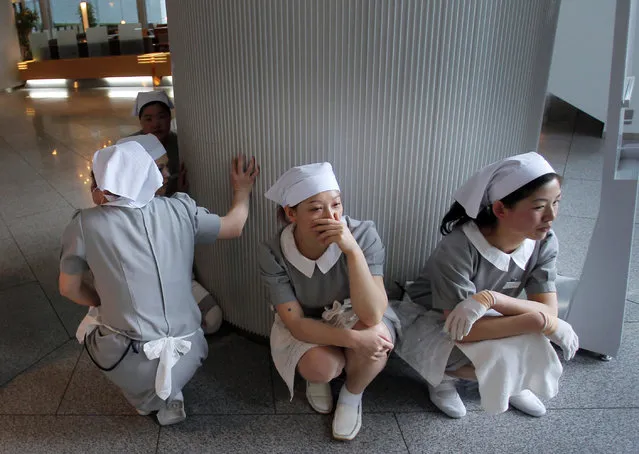
In this March 11, 2011 file photo, hotel employees squat down in horror at the hotel's entrance in Tokyo after a strong earthquake hit Japan. “I was at my desk watching the prime minister getting questioned in Parliament on TV when an ominous message from Japan's disaster early-warning system flashed on the screen: A major earthquake was about to strike. Somebody in the newsroom shouted and everyone froze. About 10 seconds later, the building started shaking violently, making the blinds slam against the windows of our 7th-floor office. I could hear the building creak and groan as it rocked back and forth. Some staffers dove under their desks. Colleague Miles Edelsten, video camera on his shoulder, came to the window behind me, filming people pouring out of the nearby building onto a plaza below. Finally, the shaking subsided – and everyone in the bureau jumped into action”. – Malcolm Foster, AP editor, former Tokyo bureau chief. (Photo by Itsuo Inouye/AP Photo)
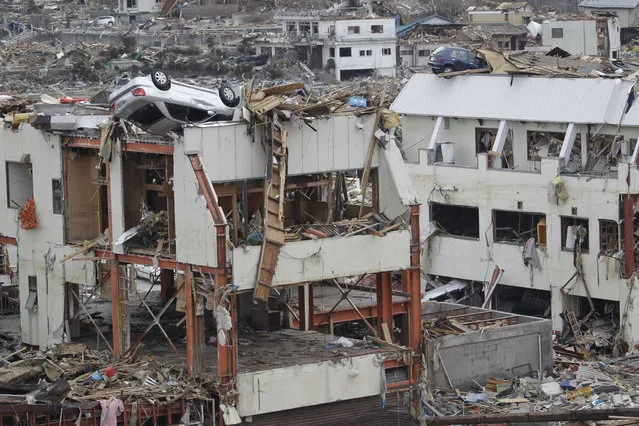
In this March 24, 2011 file photo, cars sit atop damaged buildings in Onagawa, Miyagi Prefecture, northeastern Japan after the March 11 earthquake and tsunami devastated the area. “My strongest memory was a scene I photographed in Onagawa: Cars on top of a three-story apartment building. It looked like their escape had been cut off and that they had been lifted up by the tsunami more than 20 meters (65 feet) above the ground. I was struck by the enormous power and ferociousness of nature. It looked like a scene from hell as I imagined that there were probably many dead bodies in the debris all around me”. – Koji Sasahara, AP photographer. (Photo by Koji Sasahara/AP Photo)
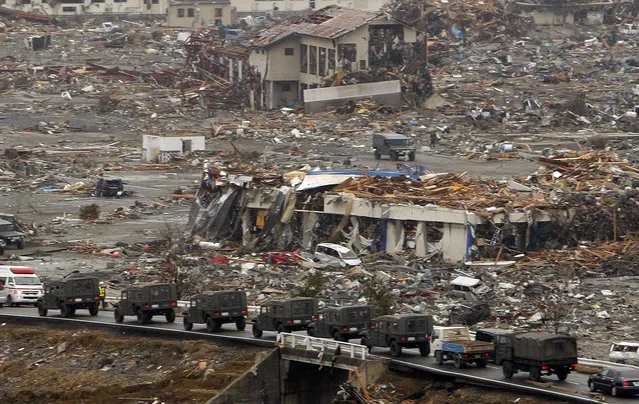
In this March 15, 2011 file photo, a convoy of Japan Ground Self-Defense Force vehicles arrives in the tsunami-hit area for recovery operations in Minamisanriku, Miyagi Prefecture after Japan's biggest recorded earthquake slammed its eastern coast on March 11. “I still think about the tsunami some nights when I'm falling asleep. I remember standing on a hilltop looking across the flattened town of Minami-Sanriku as a line of green army trucks moved through the destruction. The hill was home to one of the town's tsunami evacuation centers, and several cars parked there had been lifted up and pushed together in the corner of a lot. It was hard to imagine the water had reached this height. The first story of a villa perched on the hilltop, facing the ocean, had been eviscerated. Dead fish were scattered in a pile of broken wooden boards nearby”. – Todd Pitman, AP reporter, former Bangkok bureau chief. (Photo by Shuji Kajiyama/AP Photo)
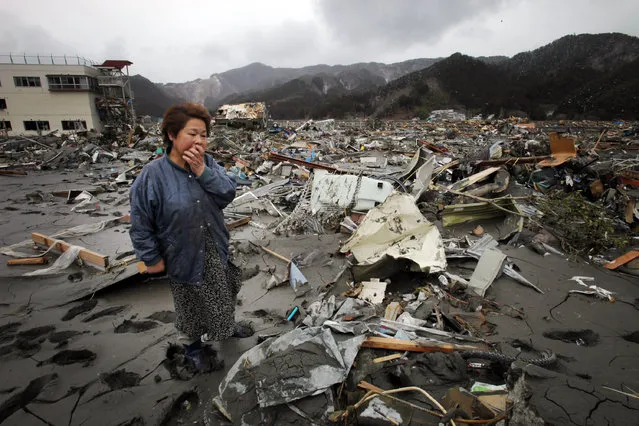
In this March 16, 2011 file photo, Reiko Miura, 68, cries as she looks for her nephew at the tsunami-hit area in Otsuchi, Iwate Prefecture, northern Japan after the March 11, 2011 earthquake and tsunami. “The first two days after the quake struck, I was on a helicopter taking aerial shots. I saw huge columns of black smoke from a flattened town. A large cargo ship was on top of a building. There was no sign of life at all. I did not want to think about thousands of people who were there when the colossal tsunami hit. I just tried to focus on what I needed to do. But an encounter I had later with an old lady who was looking for her nephew sticks in my mind. It was a cold day and the sky was covered with dark clouds. The tsunami wiped out much of her city of Otsuchi. As she carefully walked in the mud in her rubber boots, she struggled to recognize her nephew's neighborhood because there were nothing but piles of wreckage and mud”. – Koji Ueda, AP video journalist. (Photo by Itsuo Inouye/AP Photo)
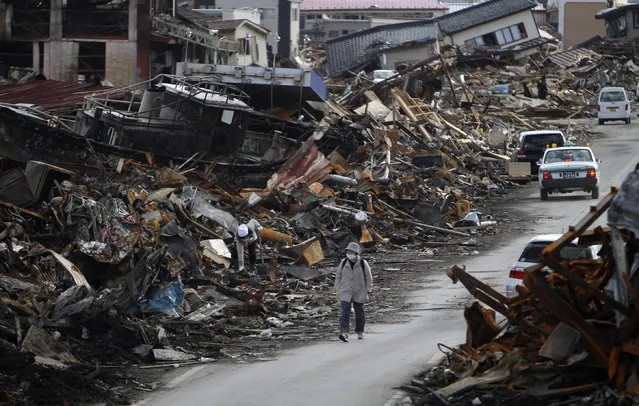
In this March 23, 2011 file photo, a resident walks between the rubble caused by the March 11 tsunami at Kesennuma, Miyagi Prefecture, northern Japan. (Photo by Shizuo Kambayashi/AP Photo)
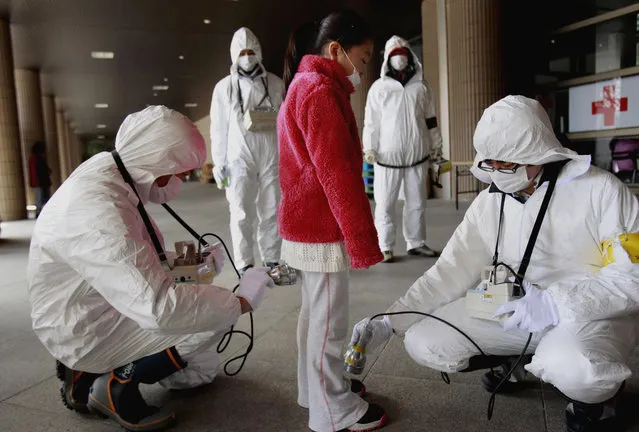
In this March 24, 2011 file photo, a young evacuee is screened at a shelter for leaked radiation from the tsunami-ravaged Fukushima Dai-ichi nuclear plant in Fukushima, northeast of Tokyo. “Standing in line day after day to be scanned for any levels of radiation was nerve-racking. The long lines at relief centers of displaced residents – mothers with crying children, fathers and the elderly – all waiting and hoping not to be the one detected by the alarm. Every few dozen people, a loud alarm chirp was heard by everyone, causing everyone to stop and look who was it. These people with the high radiation levels were then taken from the line to be further tested. It had the collective effect on everyone that this could happen to any of us. You might have been high above the water levels but straight in the radiation wind. These were not victims marked by broken bones and cut flesh but by the anxiety from an invisible threat of radiation and the deep fears of cancers that could follow”. – Wally Santana, AP photographer. (Photo by Wally Santana/AP Photo)
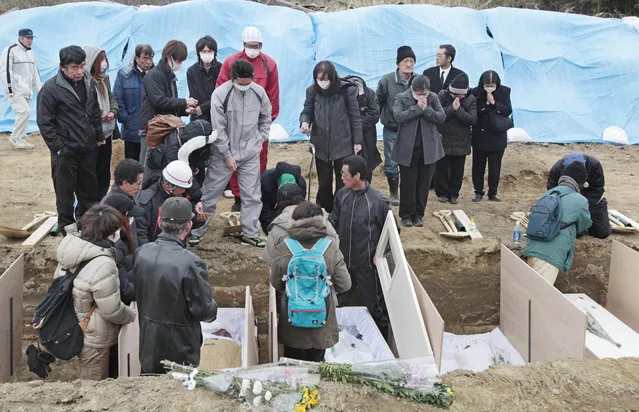
In this March 22, 2011 file photo, family members pay their final respects during a burial ceremony for the March 11 tsunami victims in Higashimatsushima, Miyagi Prefecture, northeastern Japan. “You never know what is going to touch you. For me, it was a group of families wearing pajamas and track suits on a snowy morning in Higashimatsushima, one of the hard-hit coastal cities. They were lined up along trenches dug by backhoe in a city dump. The soldiers filled the trenches one by one, lowering in plain wooden coffins numbered with magic marker. An official called out names into a bullhorn. The families watched silently. The town crematorium had been destroyed, and the bodies had to be buried before spring came. There were too many for proper rites, and the people had nothing to offer their dead. Everything would have to be dug up later”. – Jay Alabaster, AP reporter. (Photo by Mark Baker/AP Photo)
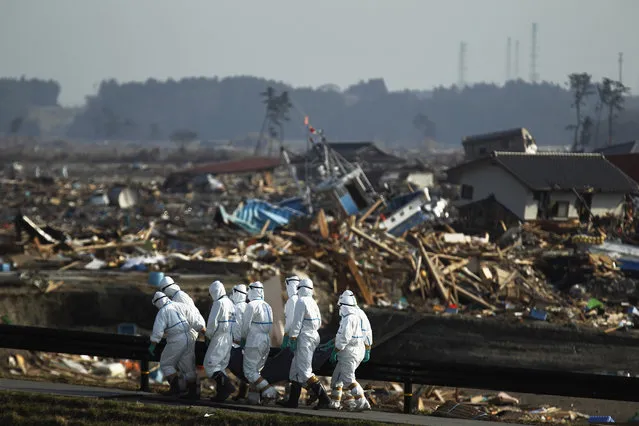
In this April 15, 2011 file photo, Japanese police officers in protective suits carry a victim at a tsunami-devastated area in the town of Namie as towers of the crippled Fukushima Dai-ichi nuclear power plant are seen in the distance, top right, in Fukushima Prefecture, northeastern Japan. “One month after the disaster struck, we slipped into the evacuation zone around the Fukushima Dai-ichi nuclear facility. We approached as near as we dared, just a few kilometers from the plant, and through my viewfinder I saw a scene straight from a science fiction movie: Men in white spacesuits carrying body bags across the gray ash-like wasteland left by the tsunami. Curtains flapping from windows of washed-up bungalows, beached fishing boats and a crumbled road filled the foreground. In the distance were the iron chimneys of the nuclear plant. The scene captured all aspects of the triple disaster, and as I stepped back from my camera I thought, “Wow, I've got it all in one frame”. – Miles Edelsten, AP former senior video producer. (Photo by Hiro Komae/AP Photo)
09 Mar 2016 12:40:00,
post received
0 comments
